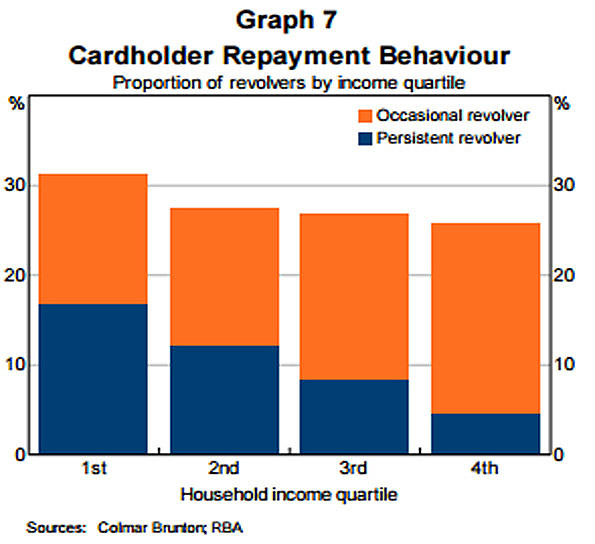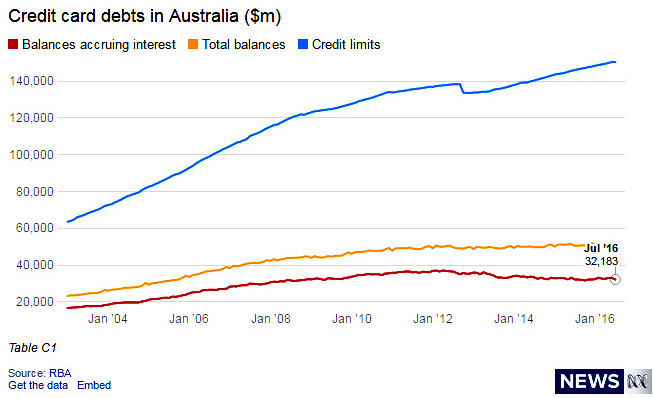|
| |
Defined Terms and Documents
Credit Cardholders or Credit Card Users
The below Credit Card
ownership and usage statistics
are sourced from:
-
ASIC
MoneySmart 'Credit
card debt clock
shows that $32.287 billion dollars in Credit
Card
Outstanding Indebtedness
is accruing interest @ 17.34% p.a. ave =
$5.60 billion interest paid p.a. by
Revolvers.
The average Credit Cardholder is paying around $700 in
interest per year if their interest rate is
between 15 to 20%.
-
Australian
Credit Card and Debit Card Statistics 2017 -
Finder showed:
- 16,735,686 Credit
Cards on issue as at 31 Oct 2016
- $32.144 billion of
Outstanding Indebtedness on
Credit Cards accruing interest
- $1,933 ave. Credit
Card balance accruing interest
@ 17.22% p.a. ave
- 70.19% of Australians
own a credit card - DOUBTFUL as you
have to be 18 or older, and some Australians
don't use plastic at all, and others use a debit
card only
-
7,515,000 Credit
Cardholders in Australia (Source:
Roy Morgan Research, 12 month average June 2016)
- on ASIC's MoneySmart webpage.
-
Below RBA Graph 7 "Cardholder
Payment Behaviour" (in RBA report
RBA Submission
to the Senate Inquiry into Matters Relating to Credit Card Interest Rates -
Aug 2015)
splits the 33% of
Credit Cardholders
that are
Revolvers into
Occasional Revolvers
(62.75%)
and
Persistent Revolvers
(37.25%)
-
Revolvers
represent 33% of
Credit Cardholders
transactions.
Below
'Credit Card debts in Aust ($1m) graph as
at July '16)
shows that
Revolvers carried $32.183 billion (of interest
accruing Credit Card debt at an ave per Credit Card debt
of $6,095 paying interest @ an ave. 17% p.a. = $1,036 pa. interest on average
per Credit Card used. This $1,036.20 pa. circa takes no account of
Late Payment Fees.
-
RBA's Submission
to the Senate Inquiry into Matters Relating to Credit Card Interest Rates -
Aug 2015
noted:
"In the
June quarter of 2015, new credit card transactions averaged around $24
billion per month. At the end of June, the total level of credit card
debt was $51.5 billion (Graph 11).
Of this amount, $33.1 billion, or around 65 per cent was bearing interest.
A simple calculation would suggest that around 75-80 per cent
[(51.5–33.1) ÷ 24 ≈ 0.77%]
of transactions on credit cards do not accrue interest. That is,
interest-paying ‘Revolvers’ account for about 30-40 per cent of
accounts, about 20-25 per cent [1.00 - 0.77
≈
0.23%] of transactions, but close to two-thirds of the
outstanding stock of debt.9"
-
Australian Treasury’s Submission to Senate Economics References Committee -
Aug 2015 noted:
"According
to a 2013 RBA survey, only around 30 per cent of credit card users reported that
they pay interest on their credit card balances (the ‘Revolvers’)."
-
Chapter 5 includes "Five extracts
that evidence that Financially Savvy Users Don't Pay - some Are Paid".
Below are the 4th extract and 5th extract:
4th extract:
From
Australian Treasury’s Submission to Senate Economics References Committee -
August 2015 noted:
"According
to a 2013 RBA survey, only around 30 per cent of credit card users reported that
they pay interest on their credit card balances (the ‘Revolvers’).
However, the share of outstanding balances that actually attract interest is
higher, at around two-thirds.".
This disparity between 30% and two thirds indicates that a small portion of
Credit Cardholders are carrying very high
Credit Card Debt Accruing Interest.
5th extract:
A footnote in
Consumer Credit Reform and Behavioural Economics: Regulating Australia’s Credit Card Industry -
2013 (provided by three eminent academics) that seeks to quantify the number of
Revolvers'
suffering
Extreme Financial And Emotional Distress,
thereby being
Persistent Revolvers. :
9 There is limited evidence
to conclude with certainty the number of Australian credit card consumers who
carry unmanageable debt, in part due to the lack of consistent
reporting by lenders.
The recent ANZ Financial Literacy Report indicates that 13% of respondents paid only the minimum
repayments on credit card balances, and 23% of respondents stated they had been charged interest on credit card
debt in the last 12 months, above n 1, 46.
It is difficult to determine, however,
what percentage of these
revolving consumers fall into the category of those experiencing unmanageable debt.
RBA figures from 2001 analysed
by the NSW Office of Fair Trading placed the figure
as high as 10% of
credit card holders, cited in
Ministerial Council on Consumer Affairs,
Responsible Lending Practices in Relation to Consumer Credit Cards,
Consultation Regulatory Impact Statement, August 2008, 16.
RBA data from 2004
suggested that 0.8% of outstanding balances were
in default, after 90 days of non‐payment: Reserve Bank of Australia, ‘Box A: Credit Card indicators’,
Financial Stability Review (September, 2004).
There were 7,515,000 Credit
Cardholders in Australia
(Roy Morgan Research, 12 month
ave. June 2016) - on ASIC's MoneySmart webpage.
Re the immediately above
"...
as high as 10% of
credit card holders,
10% of the
7,515,000 Credit
Cardholders in Australia as at June 2016 is 751,500 Credit Cardholders
being
Persistent Revolvers.
* Number of credit
and
Charge Card
accounts: 16.66
million accounts
* Credit
and charge card balance total: $52.463
billion
*
Average credit card balance: $3,160
*
Credit card and Charge Card balance total (accruing
interest): $32.207 billion (61.4% of the total
Australian credit card balance is
accruing interest)
Findings
from Roy Morgan’s Single Source survey of over
50,000 consumers pa which includes detailed coverage
of over 39,000 with major cards in "High
incomes run up relatively less debt on major cards"
- Dec 12, 2016 note:
"In the 12 months to October 2016,
holders of major cards (VISA, MASTERCARD, AMEX) intended to carry forward to
their next statement an average monthly debt of $19 billion between them.
The main contributors to this were the lower-income card holders, who on
average owed an amount equivalent to a much higher proportion of their
incomes than the higher-income groups."
McKinsey Report - May 2014 categorises 'Five Segments' of Credit
Cardholders in the USA:
1: Prosperous and content
Keep their
finances in order, use credit cards for 59 percent of their purchases and
love rewards; they dislike revolving debt. They
look for convenience and minimum effort, preferring to “set it and forget
it” rather than get closely involved with banks or card issuers.
2: Deal
chasers
Average revolving debt of
$3,802— twice the average— move their balances around to chase the best
transfer rates. This segment is the most likely to have a cobranded card (24
percent compared with 17 percent overall) and to pay an annual fee for a
reward card (19 percent compared with 13 percent). Deal chasers are highly involved
with financial products and nearly as satisfied with their financial
situation as the prosperous and
content segment
(34 and 37 percent respectively, compared with 20 percent overall), and rank
second in both income ($65,000 median) and financial assets ($150,000).
Despite carrying higher debt, they are confident about managing it and view
the economic outlook as positive. Use online banking frequently, with half
making online transactions three times a week. Acquiring and keeping
these customers calls for a balancing act, as they see themselves as pitted
against issuers in a win-or-lose game. Always striving to borrow at the
lowest cost, they try to steal the bait from issuers’ traps without
triggering fees or higher rates through mishaps or oversights.
3: Financially stressed
Carry heavy credit card
debt—nearly four times the average, at $7,453—and consider themselves unable
to control their spending or stick to a budget. Some are chronic
spendthrifts; others are mired in circumstances that force them to borrow on
credit cards to pay for essentials. Seldom shop around for better
places to put their outstanding balances and doubt they will ever get out
from under their burden of debt. Expect financial trouble for themselves and
the wider economy. Poorest among the segments, with just a quarter of the
financial assets (a mean of $44,000) of the average cardholder. Credit plays
a crucial role in satisfying this group’s day-to-day needs: keeping a roof
over their head, paying for their daily commute, keeping a prescription
filled. This is not a sustainable path, but they are unable to abandon it
just yet. Value simplicity and transparency in fees, rates and terms,
but their biggest need is for something that no credit card offers: a
mechanism allowing them to impose their own spending limits which would
enable them to carry a credit card for larger purchases that take time to
pay off, without fearing they might be tempted to use it for non-essentials.
4: Recovering credit users
Avid budgeters
who pride themselves on keeping their financial house in order, although
they still revolve an average balance of $1,726. Wary of financial
institutions, avoid the stock market as too risky, fear their bank deposits
are unsafe and blame issuers when consumers accumulate debts and fees they
are unable to pay off. Avoid using credit cards for routine purchases and
seldom respond to zero-percent teasers or high-reward offers. They prefer to
deal with bank staff in person and are less likely than other segments to
use online banking, with just 49 percent doing so. This group’s
adversarial view of issuers suggests they need reassuring that they can use
a credit card without stumbling into a “gotcha” fee or triggering a penalty
rate. Need a product that helps them budget and manage their
spending—for instance, by allowing them to define spending “buckets” for
various merchant types with monthly limits (e.g., $200 at grocery stores,
$80 at mass merchants and $150 at restaurants).
5: Self-aware avoiders
Avoid using credit cards, although
they blame themselves rather than issuers for their debt problems and worry
about the damage they could do to themselves with a credit card. Use debit
cards and cash for three-quarters of their POS purchases.
Numeracy And Literacy Range Of Australians
explains that only slightly over half the Australian population
possess the minimum required
Financial Literacy
and numeracy skills of level 3
"...to meet the complex demands of everyday life and work in the emerging
knowledge-based economy".
ABS 4228.0 2006 page 5
Financially Educated Australians are ranked level 3, level 4 or level 5 in the -
* Productivity
Commission's Staff Working Paper
Links Between Literacy and Numeracy
Skills and Labour Market Outcomes dated Aug
2010;
*
Australian Bureau of Statistics'
Adult Literacy and Lifeskills Survey
(ALLS) - 2006; and
* Australian Bureau of Statistics'
Survey of Aspects of Literacy
(SAL) -
1996.
Unlike the
Wholesale Supply Side where all the
parties (Credit Card Issuers,
Card Acquirers and
Merchants) have powerful lobby groups to protect their commercial interests, the
Retail Supply Side contains
exceedingly powerful and too often unscrupulous participants amongst the
Credit Card
Issuers, whereas
almost 8 million Australian
Credit Cardholders have no lobby group to protect their commercial interests because
Australia's Principal Regulator of the Payments System, namely the RBA considers that
"The Payments System Board of the Reserve Bank has no regulatory power over
these aspects of credit cards", notwithstanding
Unconscionable Conduct
by some Credit Card
Issuers as evidenced in
Labyrinth of
‘Concealed Spiders’. | |
|

